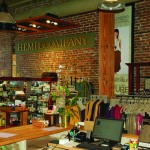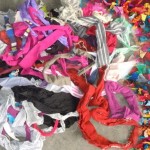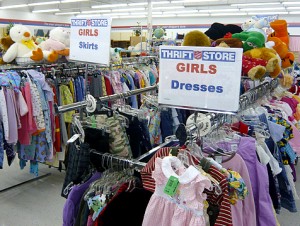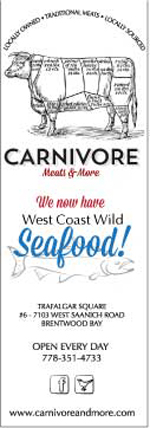Posts Tagged ‘clothes’

Buy Less, Buy Better, Buy Local
by Carole Pearson
“When we think of pollution, we envision coal power plants, strip-mined mountaintops and raw sewage piped into our waterways.
We don’t often think of the shirts on our backs. But the overall impact the apparel industry has on our planet is quite grim,” writes Glynis Sweeny in “Fast Fashion is the Second Dirtiest Industry in the World, Next to Big Oil”.
In Overdressed: The shockingly high cost of cheap fashion, author Elizabeth Cline states,“The natural resources that go into fibre production every year now demand approximately 145 million tons of coal and somewhere between 1.5 trillion and two trillion gallons of water.”
“Disturbingly, about half of our wardrobe is now made out of plastic, in the form of polyester,”
“More than anything, the sheer amount of production is a problem,” comments Bangalore University’s Lakshmi Challa in her report, the Impact of Textiles and Clothing Industry on the Environment. “From wastewater emissions to air pollution and energy consumption the textile industry weighs heavily in the environment.”
Hundreds of textiles factories line the shores of Indonesia’s Citarum River. According to Greenpeace, “The printing and dying processes are particularly chemically intensive and have contributed to the Citarum developing a reputation as one of the dirtiest rivers on earth.”
Earth can’t produce enough natural fibres to fill demand, Challa says. Synthetics are popular, low-cost alternatives but far from ideal. For one thing, they are hard to recycle. Nylon takes 30 to 40 years to decompose. Nylon production creates nitrous oxide, “a greenhouse gas 310-times more potent than carbon dioxide,” notes Challa.
Synthetic fabrics, such as polyester, nylon, acrylic, Lycra, Spandex, and PVC, are all petroleum-based, meaning they are non-biodegradable. Their manufacture uses vast amounts of water and crude oil.
“Disturbingly, about half of our wardrobe is now made out of plastic, in the form of polyester,” says Cline. People who scorn bottled water because of the plastic waste it could be guilty of owning a closet full of plastic, just in a different form.
“Of the billions of new clothing items purchased each year, 90 percent is transported from offshore factories by container ships using the dirtiest of fossil fuels – low grade bunker fuel.”
Lorna Knowles is co-owner of Victoria’s Hemp and Company which sells clothing made of natural fibres. She says, “We found the more research we did validated the path we have taken. Like the impact of polyester and even recycled polyester that is made into the fleece that people buy in great quantities.
“The fabric breaks down and produces micro-particles that go into the environment. What people don’t realize is, (micro-particles of) their clothing goes into the ocean with every washing.”
Of the billions of new clothing items purchased each year, 90 percent is transported from offshore factories by container ships using the dirtiest of fossil fuels – low grade bunker fuel – according to Sweeny.
In contrast, Hemp & Company stocks its own clothing line. “We have a local designer buying fabric from a local distributor. We employ a pattern maker for our factories in Vancouver. It keeps money in the local economy, and is good for more people,” says Knowles. The store also carries other Canadian-made clothing.
Buying fewer clothes will help the environment. As Knowles suggests, “It’s about making a conscious decision to buy less but buy better quality.”
Up next – recycling fashion in Saanich.

Where Old Clothes Go
A look at the world of recycling, reusing, and refusing, clothes
by Carole Pearson
Have you noticed the proliferation of thrift shops and donation drop-off bins around our community? The numerous charity thrift shops use the bins to collect the clothing that they use to generate revenue to support worthwhile community programs while helping shoppers stretch their dollars on clothing and household items.
Victoria’s Women in Need says its three retail shops help fund their $1 million a year operating budget. Beacon Community Services’ seven thrift stores raise $1.6 million in annual revenue and the Canadian Diabetic Association’s (CDA) Clothesline program, through its partnership with Value Village, brings in $10 million per year.
Last year in Vancouver and Victoria, The Salvation Army Thrift Store recycled 5.4 million pounds of cloth,  82,000 lbs of purses and belts, and 208,000 lbs of shoes – still too many people are throwing clothes that they feel may be unfit for re-sale, directly into the garbage.
82,000 lbs of purses and belts, and 208,000 lbs of shoes – still too many people are throwing clothes that they feel may be unfit for re-sale, directly into the garbage.
Eco Canada Textile Recycling says “Canada adds close to two million tonnes of textile waste to landfills each year.”
""
That’s just one of the problems with today’s cheap fashions. They are cheaply priced, they don’t last long in terms of wear or style, and they take effort to recycle. The low price tag of these fashions means consumers are buying and disposing of clothing in greater volumes than ever before – and far too many of these garments are winding up in our landfills.
What many people don’t know is thrift shops are not always the final destination for their used clothing nor are charities the only ones to profit from the discarded items. Andrew Brooks, author of Clothing Poverty, says, “As little as 10 to 30 percent of what is given to UK charities overall actually ends up being sold over-the-counter. It is a similar proportion in the US and Canada.”
While stained and worn clothing can’t be resold – it doesn’t necessarily have to be landfill either. Sonja Sharp’s article in the March, 2014 issue of Vice Magazine, “What Actually Happens to Donated Clothes,” states, “Of the roughly two million tons of used clothing Americans recycle each year, less than half is ever worn again: 30 percent is cut up for use as industrial rags, and another 20 percent is shredded for couch stuffing and home insulation.”
Entire industries have developed within the used apparel trade such as clothing recyclers or textile merchants, rag graders, and fibre buyers. The United Nations Comtrade Database shows exports of $185 million (2013) by Canada’s top 10 used clothing exporters. If these did not exist, one can only try to imagine how to manage this surfeit of unwanted clothing, besides stuffing landfills to capacity.
Clothing recyclers collect second-hand clothing donations by the truckload. At the warehouse, items are sorted and graded and then compressed into 100-pound bales and priced according to the contents. Most of the buyers are used clothing traders in Africa, the Indian sub-continent, and Latin America.
Speaking with The Guardian’s Marc Gunther, US-based Community Recycling president Ira Baseman “unapologetically admits that his company is a for-profit business.”
“We’re not asking for donations,” he explains. “We don’t use the D-word. It’s recycling, it’s re-use. People don’t object when for-profit companies recycle newspapers, bottles or cans,” he notes. “Why should clothes or shoes be different?”
So, instead of tossing that stained or torn shirt or blanket into the garbage, why not donate it to the Salvation Army or Value Village where it can continue to provide some good for community.
-30-
More from the Salvation Army:
Once items are collected from donation bins they are sent to a Distribution and Recycling Centre or directly to a local Thrift Store. Items are then sorted and placed on the floor.
The Salvation Army Thrift Store often receives donated clothing that cannot be sold in stores because it is torn, stained and/or overly worn. The Salvation Army Thrift Store is still able to generate funds from these clothing donations and divert them from local landfills by selling them to cloth graders.
The cloth graders re-sort the materials; turning some into rags, selling other parts for the fibre content used to make things such as upholstery stuffing and carpet padding, or resells the items in foreign markets.
This results in a win-win situation for the environment and for The Salvation Army as these clothing items stay out of our landfills and generate funds to help our organization provide community programs and services such local food banks, shelters, daycare programs and children’s camps.
Last year in Vancouver and Victoria, The Salvation Army Thrift Store recycled 5.4 million pounds of cloth, 82,000 lbs of purses and belts, and 208,000 lbs of shoes.
The Salvation Army Thrift Store works with WASTECH in Vancouver whom facilitates and manages the recycling of municipal solid waste disposal for communities in southwestern British Columbia.
The Salvation Army Thrift Store also participates in an electronics recycling program as mandated by the provincial government.
More information can be found on our website.













